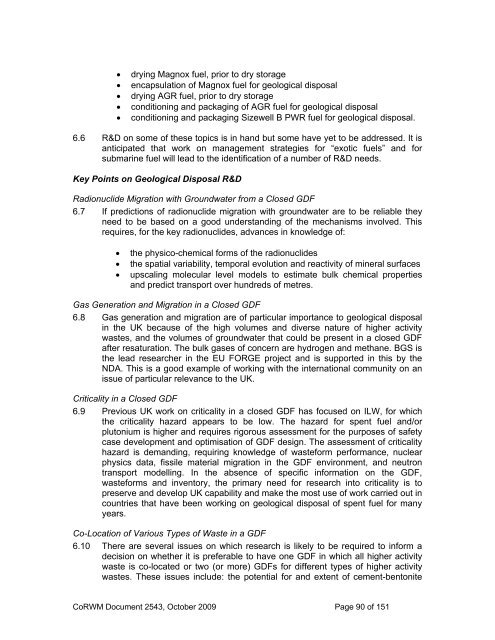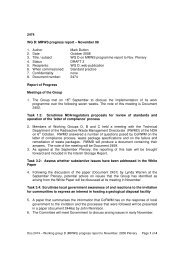2009 Report to Government on National Research and
2009 Report to Government on National Research and
2009 Report to Government on National Research and
- TAGS
- corwm.decc.gov.uk
Create successful ePaper yourself
Turn your PDF publications into a flip-book with our unique Google optimized e-Paper software.
• drying Magnox fuel, prior <str<strong>on</strong>g>to</str<strong>on</strong>g> dry s<str<strong>on</strong>g>to</str<strong>on</strong>g>rage<br />
• encapsulati<strong>on</strong> of Magnox fuel for geological disposal<br />
• drying AGR fuel, prior <str<strong>on</strong>g>to</str<strong>on</strong>g> dry s<str<strong>on</strong>g>to</str<strong>on</strong>g>rage<br />
• c<strong>on</strong>diti<strong>on</strong>ing <strong>and</strong> packaging of AGR fuel for geological disposal<br />
• c<strong>on</strong>diti<strong>on</strong>ing <strong>and</strong> packaging Sizewell B PWR fuel for geological disposal.<br />
6.6 R&D <strong>on</strong> some of these <str<strong>on</strong>g>to</str<strong>on</strong>g>pics is in h<strong>and</strong> but some have yet <str<strong>on</strong>g>to</str<strong>on</strong>g> be addressed. It is<br />
anticipated that work <strong>on</strong> management strategies for “exotic fuels” <strong>and</strong> for<br />
submarine fuel will lead <str<strong>on</strong>g>to</str<strong>on</strong>g> the identificati<strong>on</strong> of a number of R&D needs.<br />
Key Points <strong>on</strong> Geological Disposal R&D<br />
Radi<strong>on</strong>uclide Migrati<strong>on</strong> with Groundwater from a Closed GDF<br />
6.7 If predicti<strong>on</strong>s of radi<strong>on</strong>uclide migrati<strong>on</strong> with groundwater are <str<strong>on</strong>g>to</str<strong>on</strong>g> be reliable they<br />
need <str<strong>on</strong>g>to</str<strong>on</strong>g> be based <strong>on</strong> a good underst<strong>and</strong>ing of the mechanisms involved. This<br />
requires, for the key radi<strong>on</strong>uclides, advances in knowledge of:<br />
• the physico-chemical forms of the radi<strong>on</strong>uclides<br />
• the spatial variability, temporal evoluti<strong>on</strong> <strong>and</strong> reactivity of mineral surfaces<br />
• upscaling molecular level models <str<strong>on</strong>g>to</str<strong>on</strong>g> estimate bulk chemical properties<br />
<strong>and</strong> predict transport over hundreds of metres.<br />
Gas Generati<strong>on</strong> <strong>and</strong> Migrati<strong>on</strong> in a Closed GDF<br />
6.8 Gas generati<strong>on</strong> <strong>and</strong> migrati<strong>on</strong> are of particular importance <str<strong>on</strong>g>to</str<strong>on</strong>g> geological disposal<br />
in the UK because of the high volumes <strong>and</strong> diverse nature of higher activity<br />
wastes, <strong>and</strong> the volumes of groundwater that could be present in a closed GDF<br />
after resaturati<strong>on</strong>. The bulk gases of c<strong>on</strong>cern are hydrogen <strong>and</strong> methane. BGS is<br />
the lead researcher in the EU FORGE project <strong>and</strong> is supported in this by the<br />
NDA. This is a good example of working with the internati<strong>on</strong>al community <strong>on</strong> an<br />
issue of particular relevance <str<strong>on</strong>g>to</str<strong>on</strong>g> the UK.<br />
Criticality in a Closed GDF<br />
6.9 Previous UK work <strong>on</strong> criticality in a closed GDF has focused <strong>on</strong> ILW, for which<br />
the criticality hazard appears <str<strong>on</strong>g>to</str<strong>on</strong>g> be low. The hazard for spent fuel <strong>and</strong>/or<br />
plu<str<strong>on</strong>g>to</str<strong>on</strong>g>nium is higher <strong>and</strong> requires rigorous assessment for the purposes of safety<br />
case development <strong>and</strong> optimisati<strong>on</strong> of GDF design. The assessment of criticality<br />
hazard is dem<strong>and</strong>ing, requiring knowledge of wasteform performance, nuclear<br />
physics data, fissile material migrati<strong>on</strong> in the GDF envir<strong>on</strong>ment, <strong>and</strong> neutr<strong>on</strong><br />
transport modelling. In the absence of specific informati<strong>on</strong> <strong>on</strong> the GDF,<br />
wasteforms <strong>and</strong> inven<str<strong>on</strong>g>to</str<strong>on</strong>g>ry, the primary need for research in<str<strong>on</strong>g>to</str<strong>on</strong>g> criticality is <str<strong>on</strong>g>to</str<strong>on</strong>g><br />
preserve <strong>and</strong> develop UK capability <strong>and</strong> make the most use of work carried out in<br />
countries that have been working <strong>on</strong> geological disposal of spent fuel for many<br />
years.<br />
Co-Locati<strong>on</strong> of Various Types of Waste in a GDF<br />
6.10 There are several issues <strong>on</strong> which research is likely <str<strong>on</strong>g>to</str<strong>on</strong>g> be required <str<strong>on</strong>g>to</str<strong>on</strong>g> inform a<br />
decisi<strong>on</strong> <strong>on</strong> whether it is preferable <str<strong>on</strong>g>to</str<strong>on</strong>g> have <strong>on</strong>e GDF in which all higher activity<br />
waste is co-located or two (or more) GDFs for different types of higher activity<br />
wastes. These issues include: the potential for <strong>and</strong> extent of cement-ben<str<strong>on</strong>g>to</str<strong>on</strong>g>nite<br />
CoRWM Document 2543, Oc<str<strong>on</strong>g>to</str<strong>on</strong>g>ber <str<strong>on</strong>g>2009</str<strong>on</strong>g> Page 90 of 151



